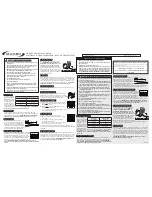
1-11
TURN-ON CHECKOUT PROCEDURE
The following steps describe the use of the Model E3620A
front panel controls illustrated in
and serve as a brief
check that the supply is operational. Follow this checkout pro-
cedure or the more detailed performance test of service infor-
mation section when the instrument is received and before it
is connected to any load equipment. Proceed to the more
detailed performance test beginning in service information
section if any difficulties are encountered.
a. Connect line cord to power source and push LINE
switch (
) in.
b. Push the V1 meter select pushbutton switch (
) to in-
position to monitor supply's V1 output voltage. With no
load connected, vary the V1 voltage control (
) over its
range and check that the voltmeter responds to the con
trol setting and the ammeter indicates zero.
c. Turn the V1 voltage control (
) fully clockwise and
short the +V1 output terminal (
) to -V1 terminal (
)
with an insulated test lead. The ammeter should indi-
cate a short-circuit output current of minimum 1.0 A +
5% at 25
°
C. Remove the short from the output termi-
nals.
d. Push the V2 meter select pushbutton switch to in-
position and repeat steps (b) and (c) for V2 output.
If this brief checkout procedure or later use of the supply
reveals a possible malfunction, see the service information
section for detailed test, troubleshooting, and adjustment pro-
cedures.
OPERATION
The dual outputs of the E3620A can be used individually, in
series, or in parallel. Each output can be floated (up to 240
volts off ground) or, the + or - terminal of either output can be
grounded to the chassis ground terminal which is located on
the supply's front panel.
Overload Protection Circuits
The outputs are individually protected against overload or
short circuit damage by separate current limiting circuits. The
circuits are factory adjusted to limit the output current to mini-
mum 1 A + 5%. The current limits are set by adjusting R63 in
the V1 supply and R34 in the V2 supply (see the schematic
diagram). No deterioration of supply performance occurs if
the output current remains below the current limit setting.
During the actual operation of the V1 and V2 outputs, if a load
change causes the current limit to be exceeded, the OVER-
LOAD LED is lighted. If overload conditions occur, the V1 and
V2 supplies will protect the load by limiting the current to min-
imum 1 A + 5%. The V1 and V2 supplies are self restoring;
that is, when the overload is removed or corrected, the output
voltage is automatically restored to the previously set value.
Operation Beyond Rated Output
The supply may be able to provide voltages and currents
greater than its rated maximum outputs if the line voltage is at
or above its nominal value. Operation can be extended up to
5% over the rated output without damage to the supply, but
performance cannot be guaranteed to meet specifications
above the rated output of 0 to 25 V at 1 A.
Connecting Load
Connect each load to the power supply output terminals using
separate pairs of connecting wires. This will minimize mutual
coupling effects between loads and takes full advantage of
the low output impedance of the supply. Load wires must be
of adequately heavy gauge to maintain satisfactory regulation
at the load.
Make each pair of connecting wires as short as possible and
twist or shield them to reduce noise pick-up. If a shield is
used, connect one end of the shield to the power supply
ground terminal and leave the other end unconnected.
If load considerations require locating output power distribution
terminals at a distance from the power supply, then the power
supply output terminals should be connected to the remote dis-
tribution terminals by a pair of twisted or shielded wires and each
load should be connected to the remote distribution terminals
separately.
Series Operation
The two outputs (V1 and V2) can be connected in series to
obtain a voltage (up to 50 V) higher than that available from a
single output. Each output control (V1 and V2) must be adjusted
in order to obtain the total output voltage. Diodes connected
internally across each output protect the supply's output filter
capacitors against reverse voltages. This could occur if the sup-
plies are connected in series and the output is shorted.
Parallel Operation
The V1 and V2 supplies can be connected in parallel to obtain a
total output current greater than that available from one supply.
The total output current is the sum of the output currents of the
individual supplies. The output voltage controls of one power
supply should be set to the desired output voltage, and the other
supply set for a slightly larger output voltage. The supply set to
the lower output voltage will act as a constant voltage source,
while the supply set to the higher output will act as a current-lim-
ited source, dropping its output voltage until it equals that of the
other supply. The constant voltage source will deliver only that
fraction of its rated output current necessary to fulfill the total cur-
rent demand.
Summary of Contents for e3620a
Page 1: ...Keysight E3620A Dual Output Power Supply Operating and Service Manual ...
Page 2: ......
Page 3: ...1 1 ...
Page 21: ...A 7 COMPONENT LOCATOR DIAGRAMS MAIN BOARD TOP ...
Page 22: ...A 8 MAIN BOARD BOTTOM ...
Page 23: ...A 9 DISPLAY CONTROLLER TOP ...
Page 24: ...A 10 DISPLAY CONTROLLER BOTTOM ...
Page 25: ...A 11 7 SEGMENT TOP ...
Page 26: ...A 12 7 SEGMENT BOTTOM ...














































